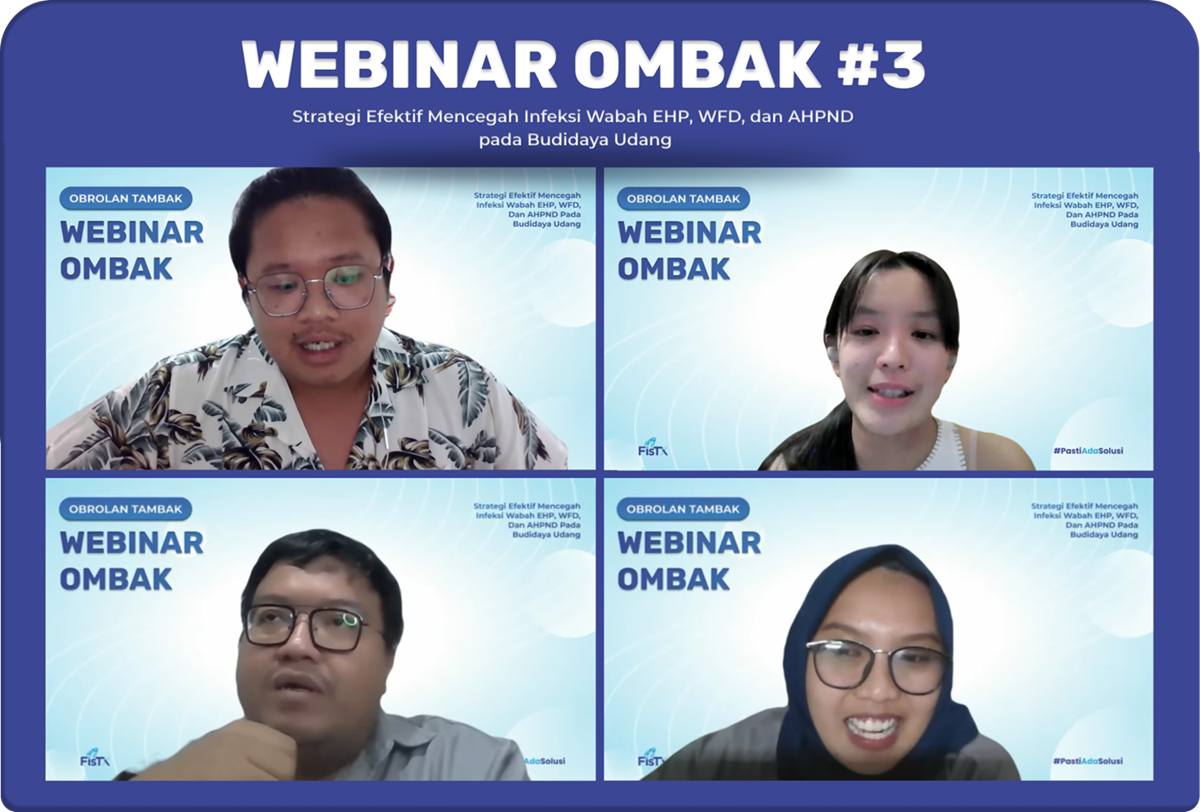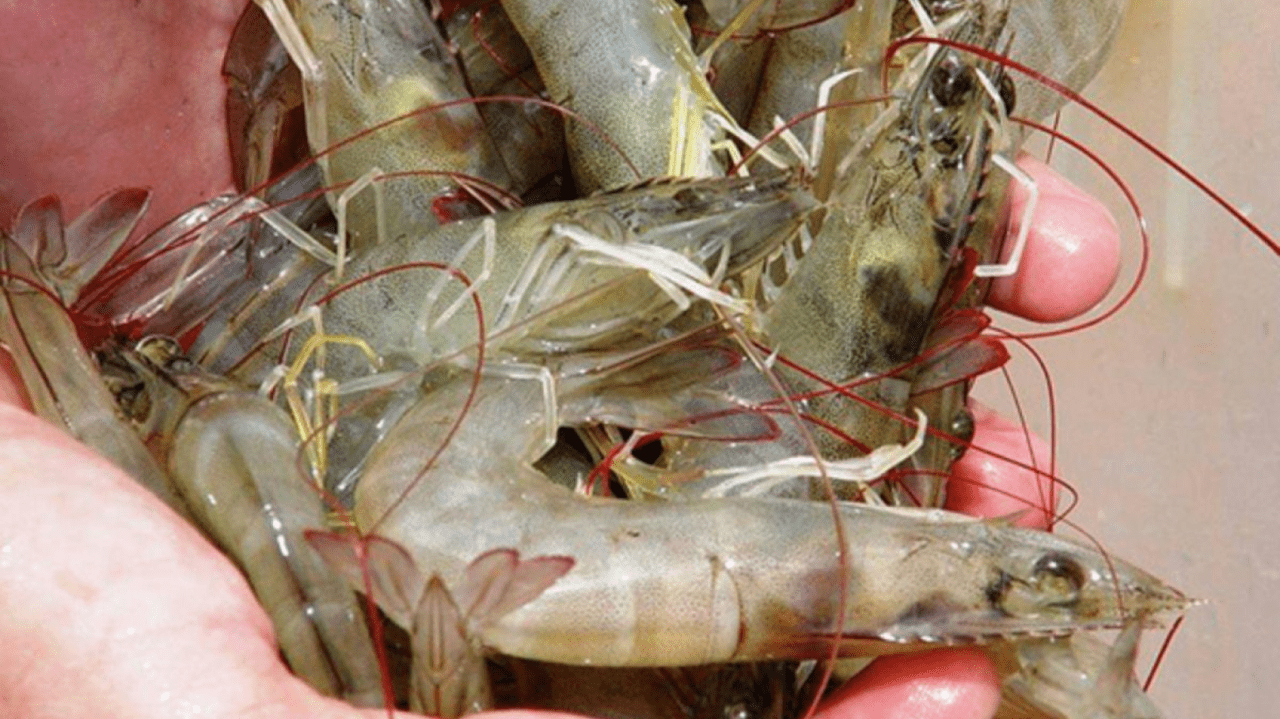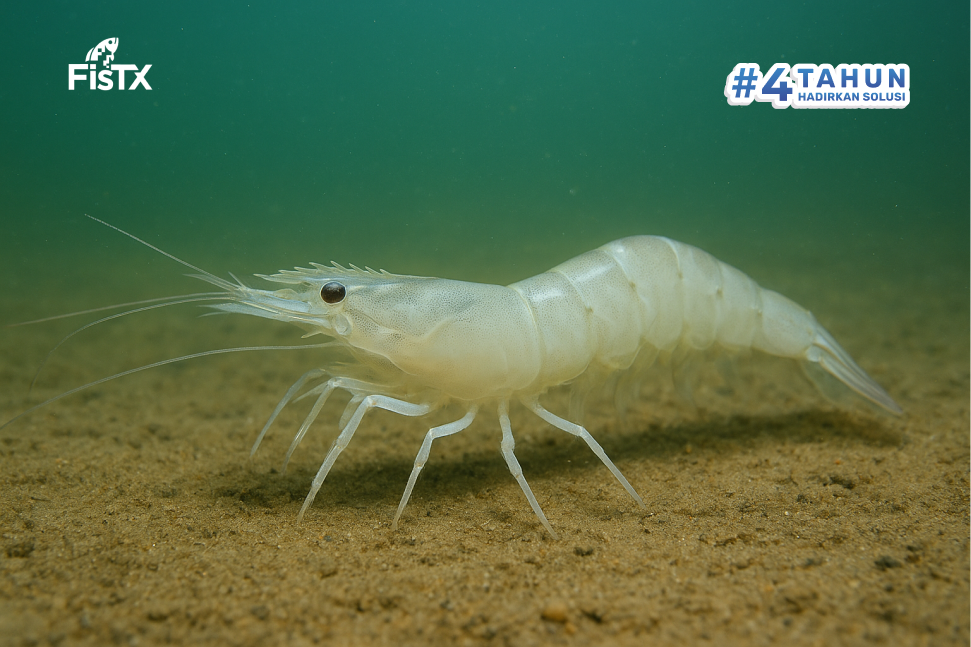
Webinar OMBAK #3: Sharing Effective Strategies to Prevent Shrimp Disease Outbreaks
Shrimp cultivation in Indonesia is facing serious threats due to the rise of several diseases that attack shrimp, especially Enterocytozoon Hepatopenaei (EHP), White Feces Disease (WFD), and Acute Hepatopancreatic Necrosis Disease (AHPND).
These three diseases have spread widely and caused significant losses, even reducing the productivity of shrimp ponds by 50% or more in some areas.
Not only does this disease seriously impact crop yields, but it also directly impacts the economic sustainability of fish farmers and the national fishing industry as a whole.
Faced with this condition, FisTx Indonesia, one of the companies that focuses on aquaculture solutions, is again holding the Webinar OMBAK. This event is designed to provide insight and solutions to farmers and other concerned parties on how to effectively prevent outbreaks of this disease.
This third Webinar OMBAK invites experts to discuss the philosophy of shrimp disease, prevention methods, and technology-based solutions that can help farmers maintain productivity amidst the threat of disease.
Getting to Know the Plague EHP, WFD, and AHPND Diseases in Shrimp Cultivation
EHP Disease and its Impact on Shrimp Cultivation

Enterocytozoon Hepatopenaei (EHP) is a microsporidia parasite that infects the hepatopancreas of shrimp and causes stunted shrimp growth. This disease is very detrimental because shrimp infected with EHP tend to grow more slowly and reduce production efficiency.
- White Feces Disease (WFD) and its Combination with EHP
Apart from EHP, White Feces Disease (WFD) known as "white feces" is also a scourge among cultivators. This disease is often associated with vibrio bacterial infection.
One of the main concerns in WFD is when this disease occurs simultaneously with EHP because it can make the condition non-recoverable. WFD causes damage to the intestines and digestion of shrimp which causes white feces.
WFD has a direct impact on shrimp health, causing mortality, and can also increase production costs.
- Acute Hepatopancreatic Necrosis Disease (AHPND)
Acute Hepatopancreatic Necrosis Disease (AHPND) or what is often called Early Mortality Syndrome (EMS) is also the most dangerous disease in the shrimp farming sector.
AHPND causes sudden death of shrimp within a few days after infection, which is caused by the bacteria Vibrio Parahaemolyticus which carries a toxin that is deadly to the hepatopancreas organ.
The impact on shrimp production is very large, especially for farmers who use intensive systems with high densities.
Philosophy of Shrimp Disease by Rico Wisnu Wibisono (COO FisTx Indonesia)
In the presentation of the first material, webinar OMBAK #3, Rico Wisnu Wibisono as COO of FisTx Indonesia discussed shrimp diseases in depth, especially EHP, WFD, and AHPND diseases.
He explained the main things to understand diseases in shrimp. His material includes the differences between the three diseases EHP, WFD, AHPND, and the characteristics of shrimp that are positive for the disease.
The material explains that there are two causes of this shrimp disease, namely bacteria and fungi, here is a more detailed explanation:
Bacterial Diseases
Like AHPND, which is related to pir A and pir B toxin genes.
Fungal Diseases
EHP is a prime example, where infection causes slow growth.
Combination of Diseases
The combination of EHP and WFD infections is often non-recoverable and requires special measures.
Next, Mr. Rico Wibisono also presented material on "Cultivation Triangle Engineering". This "Cultivation Triangle Engineering" is one way to save your shrimp.
There are 3 techniques that need to be implemented for you shrimp farmers, including environmental engineering, shrimp immunity engineering that needs to be improved, and pathogen engineering. Let's unpack these 3 techniques a little:
Environmental Engineering
In terms of pond environmental management, it is important to maintain stable water quality with parameters such as pH, dissolved oxygen, and temperature within the ideal range to reduce stress on shrimp.
Strict water quality management, sanitation control, and effective implementation of biosecurity can reduce the risk of disease spread. Apart from that, selecting healthy fry and regular monitoring is very necessary in managing disease in ponds.
Shrimp Immunity Engineering
The second element, namely increasing shrimp immunity, focuses on creating a stable and safe environment for shrimp. Good environmental conditions help maintain the balance of shrimp immunity so that they are better able to fight infections.
High-quality feed, proper feed management, and polyculture methods with tilapia are part of the strategy to increase shrimp's immune system. By reducing stress through a good environment and proper feeding patterns, the risk of infection can be reduced.
Pathogen Engineering
Third, pathogen control includes preventive practices and early monitoring of pathogens such as Vibrio (the cause of AHPND) and EHP parasites.
These steps include water disinfection with the right dose, regular monitoring using Rapid Tests, and maintaining a clean pond environment.
Mr. Rico Wibisono also emphasized the importance of quarantine ponds filled with tilapia to help reduce the concentration of pathogenic bacteria in the water.
Overall, this cultivation triangle aims to significantly reduce the risk of disease, increase production, and maintain the sustainability of shrimp cultivation businesses.
Lastly, Mr. Rico Wibisono also explained that the concept of cultivation risk management is important to be able to implement this "Cultivation Triangle Engineering" successfully. There are 3 most important things to pay attention to, namely Human Resources, Operational and Financial.
Prevention, Detection, Risk Mitigation from Dr. Cristina Assisi (Molecular Diagnostic Lead Forte Biotech)
Prevention Efforts Through Monitoring and Early Detection
The next speaker is Dr. Cristina Molecular Diagnostic Lead of Forte Biotech. Dr. Christina emphasized the importance of preventive steps, such as monitoring, early detection, and appropriate control. According to him, monitoring with the Rapid Test tool allows farmers to carry out checks quickly, easily, and accurately.
Dr. Christina also explained that parameters such as pH, temperature, and oxygen levels need to be checked so that the environment remains optimal for shrimp, while visual inspection helps detect early signs of diseases such as AHPND and EHP.
In addition, strict biosecurity is implemented by keeping the equipment clean and placing the fry in quarantine to prevent the entry of pathogens from outside. This strategy not only reduces the risk of disease transmission but also optimizes production yields and cultivation profitability.
Direct story of Hoy Hoy Shrimp Farmer with experience of contracting EHP, WFD, AHPND diseases
The interesting thing about the webinar OMBAK #3 this time is that FisTx Indonesia directly presents farmers who have experience with EHP, WFD, and AHPND diseases to share their experiences going through critical times in dealing with these diseases.
Hoy Hoy is the COO of PT. Mulia Era Nusa has a pond area of approximately 26 hectares, and on the occasion of the webinar OMBAK #3 he explained several things, including:
Effective Cultivation Steps
The first material explains the concept of structured management, consisting of five main steps:
Setting
Initial preparations such as selecting quality fry, equipment, and planning the cultivation cycle.
Operation
Operational management includes biosecurity and water quality control.
Learn
Evaluation from the previous cycle for learning in the next cycle.
Identification
Detect problems quickly and precisely, so that accurate decisions can be made.
Discipline
Discipline in implementation is the key to successful cultivation operations
The Importance of Discipline in Successful Cultivation
Mr. Hoy Hoy also emphasized that discipline is the spearhead of successful cultivation. Accuracy in implementing each cultivation step, from monitoring water quality to monitoring shrimp health, really determines the final result.
The pond workers need to have a commitment to maintaining cleanliness, discipline in water replacement, and consistency in applying strict biosecurity.
Lastly, Mr. Hoy Hoy also said that the spread of EHP, WFD, and AHPND outbreaks in shrimp cultivation in Indonesia requires serious handling through a comprehensive approach.
After the three presenters finished presenting the material that had been prepared, the participants also had the opportunity to ask questions about diseases and strategies for dealing with shrimp diseases. The enthusiasm of the participants succeeded in making the Q&A session very lively
Overall, Webinar OMBAK #3 wants farmers to be able to maintain stability and increase the productivity of their ponds through comprehensive steps and guidelines suggested by Rico Wisnu Wibisono, Christina, and Hoy Hoy.
FisTx Indonesia also hopes that the Ombak #3 Webinar will be useful in helping farmers prevent and anticipate EHP, WFD, and AHPND diseases amidst the increasing threat of disease outbreaks. Currently, the OMBAK #3 webinar clip can be viewed on FisTx YouTube (Webinar OMBAK #3)
If you are involved in the shrimp farming industry and want to know the latest information and insights, follow FisTx's Social Media Instagram at @fistx.id, or Our website Fistx so you don't miss the Webinar OMBAK schedule and other events from FisTx. See you at the next Webinar OMBAK!.
.


